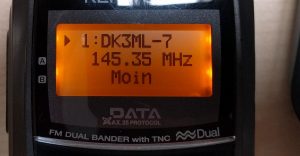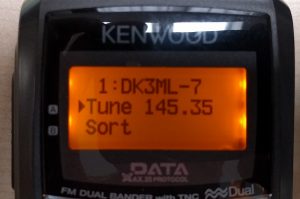|
Die Möglichkeiten sind recht vielfältig. So lassen sich neben der Frequenz auch weitere Informationen, wie CTCSS Ton, DCS Ton oder Repeater-Offset mitsenden. Dazu gibt man die nötigen Informationen direkt als APRS-Beacon-Text mit ein. Die ersten 10 Zeichen des Textes werden dabei für die Frequenz verwendet. Wichtig ist, dass man genau 10 Zeichen benutzt und sich genau an das Format hält.
Angenommen, man ist auf der 2m Anruffrequenz QRV, so sendet man:
145.50 MHz
Man kann dahinter noch weiteren Text senden, sollte aber 2 Leerzeichen setzen, da einige Buchstaben für weitere Informationen reserviert sind und der Empfänger dann kein QSY durchführen kann. Beispiel:
145.50 MHz Moin
Ist man auf einem Repeater unterwegs, so kann man auch noch CTCSS und Offset mitsenden. Für den Repeater DB0XH in Hamburg Blankenese könnte eine Meldung so aussehen:
145.662MHz toff -060 QRV auf DB0XH
Eigentlich hört der Repeater auf 145.6625 MHz, allerdings erlaubt die Frequenz Spezifikation in APRS kein weiteres Zeichen. Man muss also entsprechend runden. Die weiteren Informationen stehen für:
145.662MHz (10 Zeichen für die Frequenz)
toff (Kein CTCSS, kleines “t” für narrow-Band)
-060 (-0.6 MHz Offset für die Eingabe)
Probiert es doch einfach mal aus. Für eine bessere Erreichbarkeit unter uns APRS Nutzern 🙂
|
There are several possibilities. Additional to the frequency you can send other information like CTCSS, DCS tone or repeater offset. All this can be sent as the normal beacon text. All you have to make sure is to follow the right format, so that the receiving stations can decode it. The first 10 characters of the text can be used for the frequency. Let’s imagine you are QRV on 145.550 MHz. Then your text shouold be:
145.50 MHz
You can put additional text behind that, but be careful not to use one of the other characters used for CTCSS or other information. If you want to be sure, just add 2 spaces in between. Example:
145.50 MHz Hello from DK3ML
If you are QRV on a repeater and want to send CTCSS and offset information, that’s possible, too. For example, if you are QRV on DB0XH in Hamburg, your message should look like this:
145.662MHz toff -060 QRV on DB0XH
The normal frequency of this repeater is 145.6625 MHz, but only 10 characters are allowed in the freq spec, so you have to round the frequency and trust your receiver to decode it right. The other information in the message above are:
145.662MHz (10 characters for the frequency)
toff (no CTCSS, small “t” for narrow band)
-060 (-0.6 MHz offset for the input of the repeater)
Just try it and let’s be more reachable for other APRS users.
|


